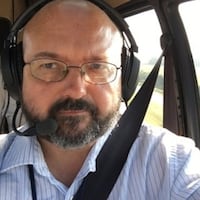To view more historical photos of the Dayton area, go to mydaytondailynews.com/business
How do you preserve some 80,000 photos of everything from the first Wright Brothers flights to the favorite showgirls of early 20th century Dayton?
If you’re a volunteer for Dayton History, very carefully.
Dayton History is curating some 70,000 to 80,000 photographs of William Preston Mayfield, a Dayton photographer whose early 20th work chronicled the 1913 flood, Orville and Wilbur Wright’s work in perfecting controlled flight, to much else besides.
Many of the photos were among the first taken from an airplane, from above downtown Dayton and other parts of the Miami Valley. Mayfield lived from 1896 to 1974 and much of his work — a generous collection of boxes and file cabinets — ended up in the basement of the North Dayton home of Marvin Christian, a photographer who worked for Mayfield in his studio.
Dayton History took ownership of the collection and now has staff and volunteers painstakingly scanning and preserving the photos for a search-able digital database. (Some of the photos, about 1,300, are available at DaytonHistory.org. Start with the photo archive link in the middle of the home page and type “Mayfield” in the search field.)
Once complete, researchers will have a treasure trove of photos that can be recalled with the use of keywords — autos, Mead, NCR, Delphi, Wright Brothers and much else besides.
Some of the photos and images may be used to market products that use the Wright Brothers’ name in a licensing agreement between Dayton-based Wright Brothers USA LLC and Shinola, an American manufacturer of watches and bicycles, said Brady Kress, Dayton History chief executive.
Wright Brothers USA is a recently formed merchandise-licensing firm. It will manage the Wright Brothers trademark worldwide.
Half of the funds generated by the trademark business will be given to The Wright Family Foundation, whose concern is preserving Hawthorn Hill, the Oakwood mansion that Orville Wright called home. The foundation transferred the home to Dayton History last summer but still supports the home.
“They’ve been looking for some photos to use in concert with their marketing efforts over there,” Kress said. “They didn’t want the standard images that so many of us see.”
Some of the Mayfield photos are “common,” but most will likely be new, even to those conversant with Dayton history.
Public domain images are familiar, but Kenneth Botts, principal with Wright Brothers USA, wants something unique.
“It’s required us to dig a little deeper as we build the Wright Brothers brand,” Botts said.
“Some of the images have never been published,” Kress said.
Kress enjoys going through boxes of the photos. He points to a shot of magician Houdini performing in front of the Dayton Daily News’ Ludlow Street offices in 1915, or a shot of an 1920s “urban car,” an early bus, off what today is Southern Boulevard in Kettering.
“Every one of these tell such stories and can help with solving mysteries,” Kress said.
Staff and volunteers are taking the old glass plates out of original acidic envelopes and placing them in acid-free sleeves, said Mary Oliver, Dayton History collections director. The photos are scanned individually into the database.
“We have rehoused a little over 3,000 glass negatives,” Oliver said. “Through our combination of volunteers and staff, we have about 1,300, 1,400 (photos) in the database so far. So it’s a multi-year process.”
In all, the project could take two to three years, which Oliver called “very aggressive.”
About the Author
